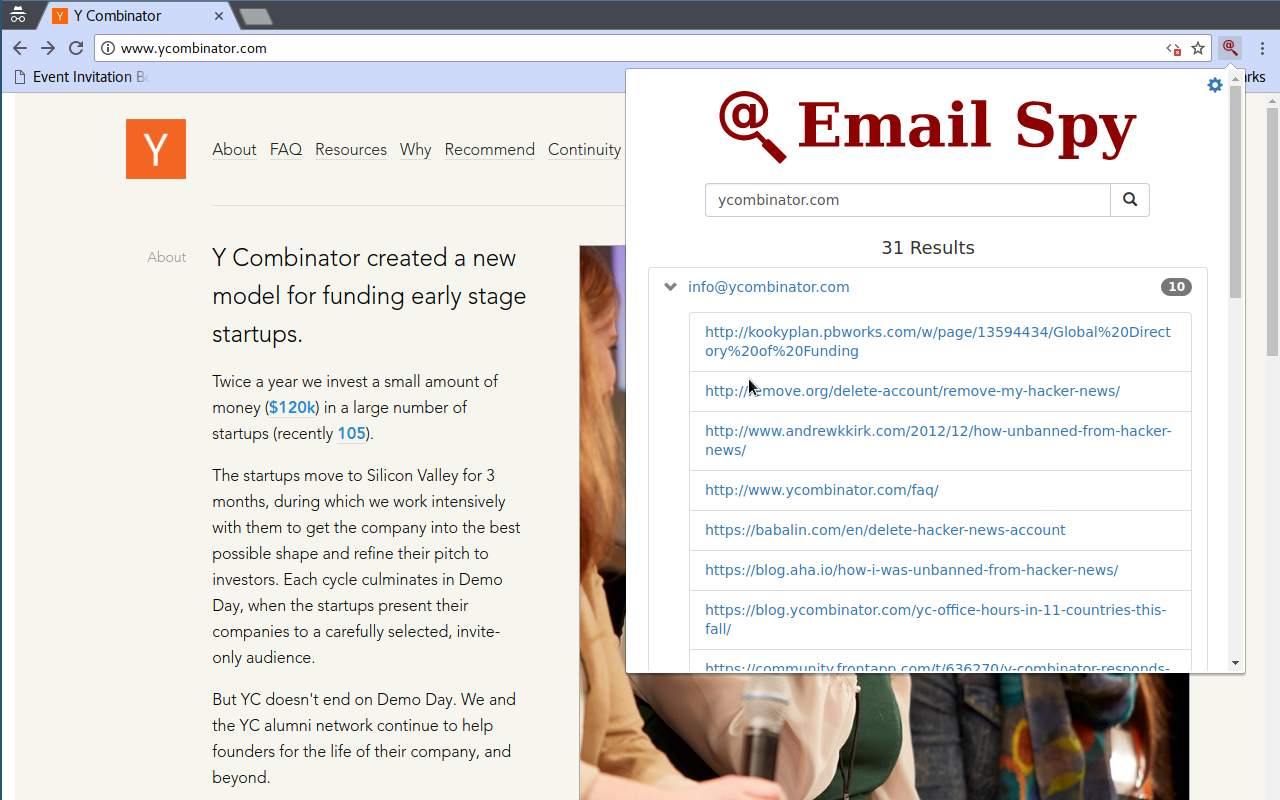By Evan Sangaline | May 17, 2017
Introduction
Lead generation is a top priority for most successful companies and helping businesses find potential clients is a big part of what we do here at Intoli. Today, we’re pleased to announce a new open source marketing tool that makes it possible to find contact emails for any web domain with a single click. It’s called Email Spy and you can get the source on GitHub or install it directly as a Chrome extension or a Firefox addon.
Sourcing emails for domains isn’t a totally new idea- services such as hunter.io have been around for a while- but we believe that Email Spy is more than just a free hunter.io alternative. By virtue of being open source, it’s easy to customize Email Spy and add functionality that fits in with your unique business workflows. We’ve already included some additional features, such as email templating, and we hope that the community will contribute back the improvements that they develop based on their own use cases.
Whether you decide to add in custom features or not, Email Spy will make your life a lot easier if you send out a lot of cold emails. Additionally, it will help you make sure that your emails are going to the right place within the companies that you’re contacting and this can make the difference between receiving a warm response and being completely ignored. Now that we’ve taken a look at how Email Spy can help you make the most of your marketing efforts, let’s see how easy it is to use.
Using Email Spy
After installing either the Chrome extension or the Firefox addon, you should notice a new icon in your browser toolbar that looks like a visual portmanteau of a magnifying glass and an “@” symbol.
![]()
Simply click on that icon while you’re on any website that you would like to contact and a popup will appear with a list of contact emails sorted by number of appearances.

You can then click on any one of these email addresses to compose an email in the client of your choice, or you can further investigate the context of the emails before deciding on which to contact.
The numbers next to each email address represent the number of sources where each email address was found. You can get more details on these sources by clicking the expansion arrow to the left of any email address.

This view shows a link for each of the web pages where the address was seen. You can click on any one of them to view the page in a new tab or you can simply mouse over the link to see a small snippet of the email address’ immediate context.

The provided context can be extremely helpful when trying to determine which email address is the most appropriate one to contact.
More advanced features can be found by visiting the extension’s options page by either clicking on the small gear icon in the popup or right clicking the toolbar icon and selecting “Options.” This will open a new tab that looks like this.

You can use the email template form to specify a base email that you would like to use as a starting point for the individual emails that you’re sending. This can save a lot of time when you’re planning on sending out a number of very similar emails.
All you need to do is enter and save your template email’s subject and body on the options page and then each of the email links will automatically prepopulate the compose window of your email client. Here’s an example of what the new compose window would look like if you use Gmail.

That’s it for now, but we hope to add more features in the near future!
Wrap Up
If this sounds like something that you might find useful then hop on over to the Chrome Web Store or the Mozilla Addon Site (the Firefox addon is pending review) to give it a test drive. As you’ve seen, it couldn’t be any easier to use once you have it installed. Also feel free to watch or star the project over on GitHub so that you can stay informed about new feature additions.
If you’re looking for a more sophisticated or customized lead-gen solution then please do reach out to us. We can help you source, aggregate, and process any data that your business needs.
Suggested Articles
If you enjoyed this article, then you might also enjoy these related ones.
Breaking Out of the Chrome/WebExtension Sandbox
A short guide to breaking out of the WebExtension content script sandbox.
User-Agents — Generating random user agents using Google Analytics and CircleCI
A free dataset and JavaScript library for generating random user agents that are always current.
A Slack Community for Developers to Discuss Web Scraping
Intoli is launching a new Slack community called Web Scrapers where developers can chat about web scraping.

Comments